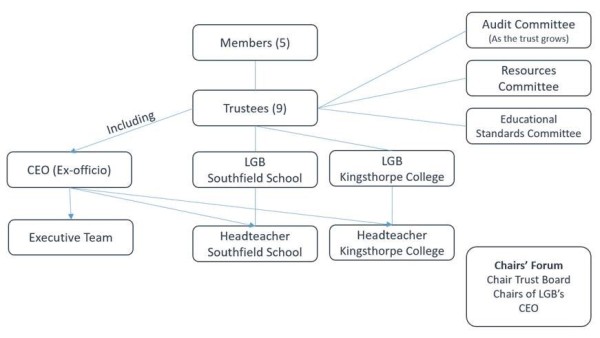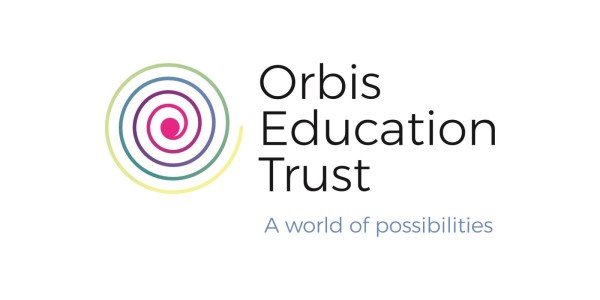Orbis Education Trust
We are part of Orbis Education Trust, a Northamptonshire based Trust, passionate about empowering students by providing world-class education and enrichment experiences which go hand-in-hand with success.
The Trust formed in 2021 and includes our school and Southfield School in Kettering. The Trust has also been successful in a bid for a new 11-16 free school in the East of Kettering – Hanwood Park School. Planning and development for this school is now underway.
Orbis supports and empowers schools to deliver a bespoke curriculum and inclusive enrichment programme allowing students to develop academically alongside building aspiration and resilience.
They invest in and support our highly skilled staff making it easy to access opportunities for continued professional development. The Trust lives by its values – Optimism, Resilience, Balance, Individuality and Synergy – and a safe nurturing environment enables staff and students alike to thrive.
The Trust has collective passion to deliver a world-class education, and the highest possible academic outcomes. Within the Trust we all collaborate to share ideas, spread best practice, support and challenge each other, to bring out our very best.
Orbis Education Trust Contact details
Lewis Road, Kettering
01536 513063

What is a Multi-Academy Trust?
A Multi-Academy Trust (MAT) is a group of academy schools who agree to work together, overseen by an overarching charitable trust.
Why are we considering joining a Multi-Academy Trust?
Rather than join a large existing Multi-Academy Trust and potentially lose some of the unique character of our schools, we want to be the leaders in this process by helping to shape the formation of Orbis Education Trust.
By joining at this early stage of Orbis’ formation, we will be able to help lead the way and retain our school’s individual characteristics, building upon the huge success that we have had and form a strong partnership moving forward.
By becoming a MAT, we can secure economies of scale, as well as provide more opportunities for staff development and collaborative work.
Why now?
We want to shape and secure the best possible future for the children in our schools now, as well as those who will join our schools in the future. We feel passionate about leading this process so that we can determine, as far as possible, what our formation of schools will look like, protecting our unique characteristics, and established vision and ethos.
The direction of travel indicated by the government is such that all schools will be expected to join a MAT or form a MAT in the near future – we want to be in control of this process and choose our direction rather than be dictated to.
What are the benefits of joining a MAT?
In our opinion the benefits are numerous; the key ones are outlined below:
- Optimising student outcomes for all member schools.
- Increasing opportunities to improve the life chances of all students across the trust.
- Opportunities for sharing best practice amongst all staff (both teaching and support) across member schools through enhanced continuous professional development and collaboration.
- Enhanced opportunities for professional advancement through membership of a larger organisation, alongside a greater positive influence over staff retention and recruitment.
- Access to more funding.
- Spreading overheads to achieve economies of scale and, potentially, an enhancement of levels of support.
- Enhanced opportunities for income generation.
- Enhanced organisational resilience.
- The opportunity to collaborate with other schools that share the same ethos and values.
- Opportunities for students to share enrichment activities. For example, the schools together in the MAT might be able to offer vocational trips that would not be possible as stand-alone schools.
What are the risks of becoming a MAT?
Some stakeholders may be concerned about the financial arrangements which will be put in place in case these adversely affect their own school, about the degree of independence their school will have in managing and recruiting staff, in setting a curriculum and about the way that leadership and governance will function within the MAT.
Both schools have a good track record in managing these risks in their respective schools with experienced and knowledgeable staff both at senior leadership and governance levels.
Why can’t we stay as we are?
As a stand-alone academy, opportunities for collaborative working, sharing best practice and enrichment are significantly reduced. There are less funding and economies of scale opportunities.
How is the decision made?
Due Diligence has already taken place between the two schools. This is the process of investigating an organisation prior to entering into a contract with it. This ensured all parties have confidence in the merits of the individual schools proposing to join the MAT. The stakeholder engagement period, outlining the proposal, will run from 26th November to 10th December. The Department for Education will review the MAT proposal with a final decision likely in the new year.
What factors have been considered during the due diligence period?
The following aspects will be considered during the due diligence process:
- Finance
- Buildings
- Educational Standards
- Organisational Structures
- Legal and regulatory compliance
- IT
If we join will we lose our individuality?
We recognise that schools have their own unique identity, and we want to celebrate this. We see this as a key benefit of being part of our MAT. There is currently no expectation that an individual’s school’s uniform, name or its distinctiveness would be altered as a result of our school joining the MAT.
Who will appoint the CEO? How will that person be selected?
The CEO has been appointed. Steph Roberts (Headteacher at Southfield School) has been appointed as CEO of the new Orbis Education Trust. In time, a new Headteacher will be appointed at Southfield School.
What will happen to the respective governing bodies of each school?
It they will get a little smaller and become Academy (local) Governing Boards. They will still maintain authority for many aspects of school activity, particularly around teaching and learning, but will have accountability to the MAT Board of Trustees on more long-term strategic matters.
What would the changes mean for existing staff?
In circumstances where a school merges with another school or becomes part of a trust or group, staff employed by the original school(s) will be protected by statutory regulations known as the Transfer of Undertakings (Protection of Employment) Regulations 2006 (TUPE).
Where an existing school becomes an academy or merges into a multi-academy trust (MAT), there will usually be ‘a relevant transfer’ under TUPE.
TUPE operates to ensure that staff working in the school, who have a contract of employment or a similar working relationship with the employer, automatically transfer. They will remain on their existing terms and conditions. These terms and conditions will include those set out in their contracts of employment before the transfer took place and may include those set out in the School Teachers’ Pay and Conditions Document (STPCD) and the Conditions of Service for School Teachers in England and Wales (the ‘Burgundy Book’).
Under TUPE, existing staff become employees of the new employer, and all rights, powers, duties and liabilities connected to the employment relationship then transfer from the old employer to the new employer. Any action taken by the old employer in respect of the employee is treated as having been taken by the new employer.
How will the TUPE process happen?
We are committed to engaging with staff and recognised unions on the TUPE process if the proposed MAT goes ahead.
There is a statutory obligation on the current employer to inform representatives of certain matters in writing.
These are:
- the fact that the transfer is to take place;
- the date of the transfer and the reasons for it; and
- the legal, economic and social implications of the transfer for any affected employees and the measures which the employer envisages it will, in connection with the transfer, take in relation to any affected employees or, if it envisages that no measures will be so taken.
Will there be a change in the salary scales our school employees are currently on?
Staff will transfer on no less favourable terms and conditions. Any proposed amendments in the future would only be following consultation with staff and unions.
What will be the process for staff progression – performance management? Will there be other opportunities?
It is envisaged the MAT will bring opportunities for staff training and staff progression, and we see this as a major advantage of schools joining the MAT.
What is the situation regarding teacher and support staff pensions once our school becomes an academy?
Teachers working in an academy fall within the scope of the Teachers' Pension Scheme (TPS), just as if they were employed in a Local Authority maintained school. Staff transferring from a maintained predecessor would simply continue their membership of the scheme. As the employer, the MAT would be responsible for remitting contributions to the TPS and for all other administrative responsibilities that fall to employers who employ teachers who are subject to the teachers' pensions regulations.
The MAT will also ensure that the Local Government Pension Scheme (LGPS) arrangements stay in place for non-teaching staff. As part of the conversion process, the LGPS scheme’s administrators will undertake an actuarial assessment to determine how much the MAT will need to contribute and the terms of that contribution. This may be higher than at present. In short, the school staff will not see any impact on their pensions because of the conversion to academy status. The MAT’s funding agreement requires it to ensure that all staff employed by it have access to the TPS or the LGPS (as applicable).
What about continuous service?
All previous service will count as continuous service when a member of staff transfers to the MAT.
Would staff be expected to work in the other schools?
No. Whilst staff would not be required to move around the MAT, there may be opportunities for staff to work at other schools within the MAT or for staff to seek a more challenging role across more than one school, as part of their career development. There may also be occasions when one of the schools in the MAT urgently needs a member of staff for a short period of time. This would have to be agreed upon by all parties. There would also be opportunities for staff to cross-fertilise ideas and share good practice. There is no intent to alter staff contracts or to force them to work at other sites. It is more about sharing and developing expertise. Consultation will take place on any proposed changes in the light of the needs of schools within the MAT.
How will students be affected?
Students will not notice any differences to their daily routine. They will be in the same uniform, in the same classrooms, with the same staff. However, through greater opportunities for collaboration, sharing of ideas and resources, we expect that the MAT will allow us to further develop and provide an exceptional educational experience for students.
Will students be expected to attend lessons at the other school?
No, students will continue to be taught at their own school, but greater opportunities will be available to collaborate across the schools with enrichment.
Would changes be made to the length of the school day and to term dates?
No, we would not seek to make changes to the length of the school day or to term or holiday dates. If this was something that we felt in the future could benefit the students, we would consult with all stakeholders.
Would the schools have to change their names?
No, schools would retain their names and uniform policies.
How much say will individual schools have in their own budgets?
Individual schools will still set their own budgets with assistance from the MAT. Budgets will need to be signed off by the school’s local governing body, and then the MAT Board, prior to formal submission to the ESFA.
Will all the schools in the MAT have the same policies?
Both schools will aim to utilise the best practice from all member schools in revising both statutory and non-statutory policies and consulting on their wording before implementation across the MAT.
What will be the process should our school’s results drop, or an Ofsted report identifies areas for improvement?
The MAT is responsible for overall school performance and will continually monitor standards, aiming to intervene before an Ofsted inspection if students were not making the required progress.
The MAT would support the school ‘s action plan to improve outcomes for students and broker external support, if required. Equally, this is a two-way process and we would expect schools to notify the MAT of any issues.
The MAT would assist in the process to ensure that areas for developments listed in an Ofsted report and section 48 report are followed up.
Will admissions arrangements change?
The Trustees would hold overall responsibility for admissions and would delegate this to the Local Governing Board.
Who is the MAT accountable to?
The MAT is accountable to the Secretary of State. As a company limited by guarantee, the MAT must prepare and file an independently audited annual report and accounts with Companies House.
How large could the MAT become?
The intention is that the MAT remains a local MAT, supporting schools in our area. Any growth of the MAT will be carefully managed and any schools wishing to join in the future will be considered thoroughly. Above all else, alignment between culture, ethos and values will be the non-negotiable factor.
How would the schools be funded?
If we become a MAT, the funding would come to the school via the Department for Education. The schools in the MAT would be responsible for their own budgets. They would pay a ‘top slice’ to the MAT to cover shared costs.
How will SEN funding work?
Special needs remain the responsibility of the Local Authority, so the LA is obliged to deliver the same levels of support to academies as they do to Local Authority maintained schools. This includes access to high tariff needs funding as well as access to specialist provision via the same systems and procedures that maintained schools are subject to.
Who makes the final decision on whether each school joins the MAT?
The Members/Governing Bodies of each school depending on each individual school’s status.
Would other schools join the group and how would the decision be made to do this?
Any decision on additional schools joining our group would be made by the Board of Trustees. Any school that joins us moving forward would be expected to abide by our vision, ethos, and governance structure. They would also be required to contribute to and learn from the other schools within the group.
Would a sponsor be appointed to oversee the schools now or in the future?
No, this is a school-led process and we have existing expertise within our group to continue building on the journey that our schools are on. Sponsors have been traditionally used where a school is deemed to be in need of making rapid improvement and is in difficulty.
Can the school withdraw from the MAT?
Schools are able to withdraw right up to the point that they sign the Funding Agreement. Once this is signed there is a legally binding agreement between the Secretary of State and the academy, and the termination process would require a long notice period.
How can I find out more?
There is more information about MATs and academies on the DfE website: http://www.education.gov.uk/academies
How can I make representations and when is the closing date?
The closing date for representations to be made is Thursday 10 December 2020.
Representations can be made directly to the Department for Education by emailing RSC.SCNWLON@education.gov.uk




